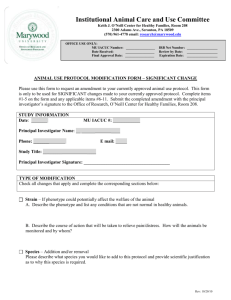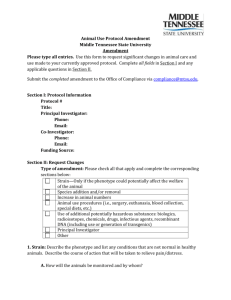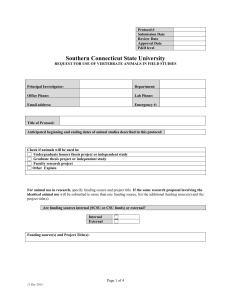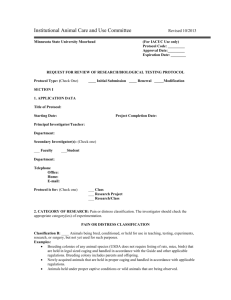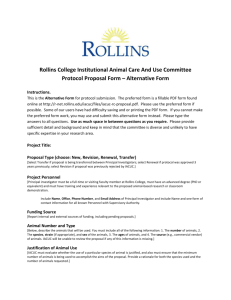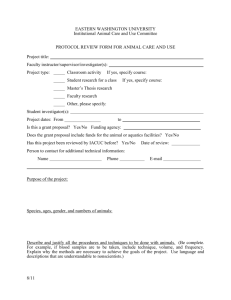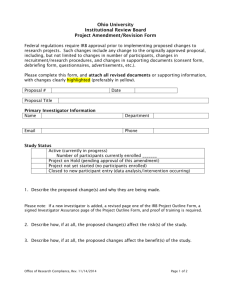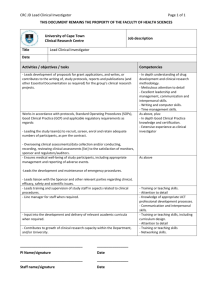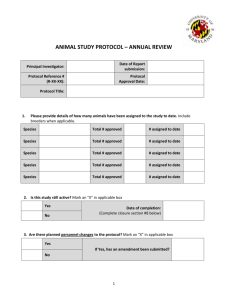Protocol Amendment Form - Stevens Institute of Technology
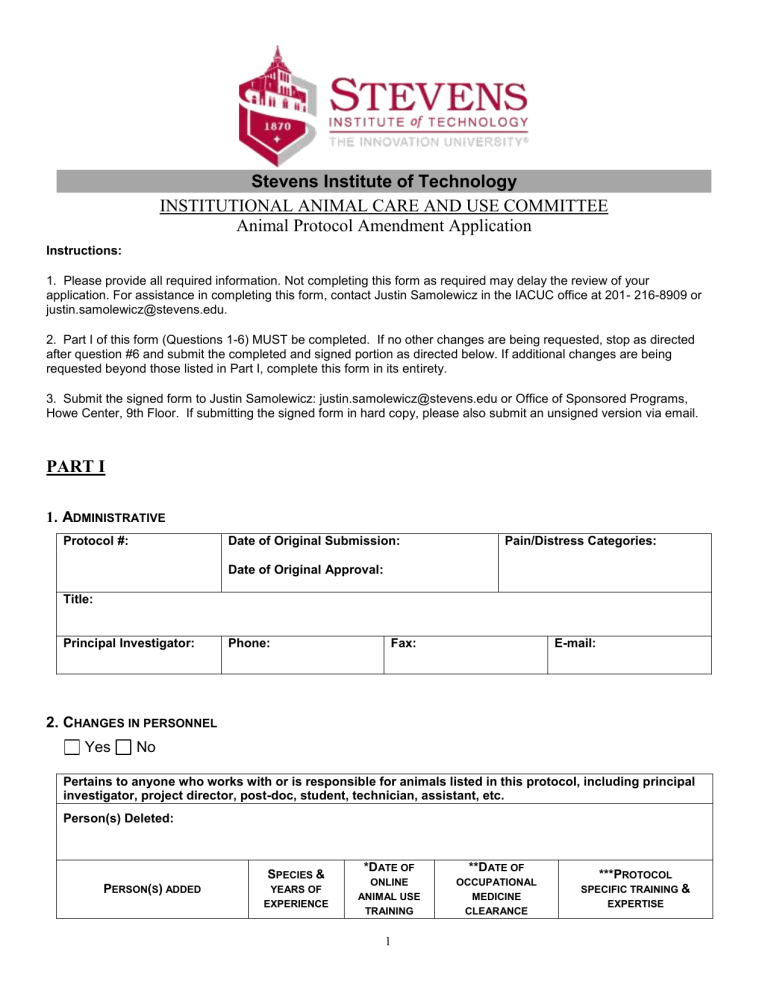
Stevens Institute of Technology
INSTITUTIONAL ANIMAL CARE AND USE COMMITTEE
Animal Protocol Amendment Application
Instructions:
1. Please provide all required information. Not completing this form as required may delay the review of your application. For assistance in completing this form, contact Justin Samolewicz in the IACUC office at 201- 216-8909 or justin.samolewicz@stevens.edu.
2. Part I of this form (Questions 1-6) MUST be completed. If no other changes are being requested, stop as directed after question #6 and submit the completed and signed portion as directed below. If additional changes are being requested beyond those listed in Part I, complete this form in its entirety.
3. Submit the signed form to Justin Samolewicz: justin.samolewicz@stevens.edu or Office of Sponsored Programs,
Howe Center, 9th Floor. If submitting the signed form in hard copy, please also submit an unsigned version via email.
PART I
1 . A DMINISTRATIVE
Protocol #: Pain/Distress Categories: Date of Original Submission:
Date of Original Approval:
Title:
Principal Investigator: Phone: Fax: E-mail:
2. C HANGES IN PERSONNEL
Yes No
Pertains to anyone who works with or is responsible for animals listed in this protocol, including principal investigator, project director, post-doc, student, technician, assistant, etc.
Person(s) Deleted:
P ERSON ( S ) ADDED
S
PECIES
&
YEARS OF
EXPERIENCE
*D ATE OF
ONLINE
ANIMAL USE
TRAINING
1
**D ATE OF
OCCUPATIONAL
MEDICINE
CLEARANCE
***P
ROTOCOL
SPECIFIC TRAINING &
EXPERTISE
/ /
/ /
/ /
/ /
/ / / /
/ / / /
* For each new person, attach a signed and dated copy of CITI Program animal training certification. An amendment in which personnel are added will not be accepted or reviewed without this documentation.
**For each new person, attached a signed and dated copy of Occupational Medicine Compliance
Certification. An amendment in which personnel are added will not be accepted or reviewed without this documentation.
*** For new personnel without experience, identify trainer and trainer’s qualifications:
3.
C HANGES IN STRAIN AND / OR NUMBER OF ANIMALS TO BE USED
Yes No
A. In table below, break down currently approved animals by strain and/or pain category on left and indicate changes on right.
Strain
O RIGINAL A PPROVAL
USDA Pain
Category*
Number of animals in originally approved protocol
Number added in all previous amendments
Strain
A MENDMENT C HANGES
USDA Pain
Category
Number of new animals
To be bred on this protocol**
To be purchased or received as donation
*Note that if, along with change of strain and/or animal number, there is to be any change of pain category different than the original pain category, then Part II of this form must be completed.
**If this protocol does not already include breeding, details of any proposed breeding must be provided in
Part II of this form.
B.
Total number of new animals:
2
4. A DDITION OF PERMISSION TO TRANSFER ANIMAL TISSUE ( S ) AND / OR CARCASS ( ES ) TO APPROVED
ANIMAL TISSUE PROTOCOLS .
Yes No
Note: If any aspect (diet, biopsies, surgery, etc.) of the approved Animal Protocol will be modified specifically to accommodate an Animal Tissue Protocol, then Part II of this form must be completed.
5. R EASON FOR PROPOSED CHANGES .
Briefly explain the reason for the proposed changes to the protocol, and describe how the changes relate to the existing approved protocol. If an increase in number of animals is requested, then describe how the number of additional animals was derived (statistical analysis may be required).
6. P ROTOCOL REVIEW AND SIGNATURES
Yes No If you answered Yes to question #4, will any aspect of your approved Animal Protocol
(diet, biopsies, surgery, etc.) be modified to accommodate an Animal Tissue Protocol?
Yes No Upon review of your protocol, do any parameters such as drug dosages, etc. need to be revised?
Yes No As a result of the protocol changes proposed in this amendment, will any animals be subjected to a different USDA pain category than previously indicated?
Yes No Are you requesting any protocol changes beyond those indicated above?
IF YOU ANSWERED NO TO ALL FOUR QUESTIONS ABOVE, STOP HERE, SIGN AND SUBMIT ONLY PART I.
IF YOU ANSWERED YES TO ANY OF THE QUESTIONS ABOVE, FILL OUT PART II OF THIS FORM, ATTACH
ANY RELEVANT APPENDICES AND SIGN AND SUBMIT THE COMPLETE FORM.
Signature of Principal Investigator Date
Signature of Sponsor/Mentor (IF APPLICABLE)
Approval Signature (IACUC Chair or Co-Chair)
Date
Date
3
IF YOU ARE NOT PROPOSING ANY ADDITIONAL PROTOCOL
MODIFICATIONS, STOP HERE
4
PART II
7. C HANGES IN EXPERIMENTAL METHODS OR ADDITION OF NEW PROCEDURES
Yes No
If yes, describe all changes in experimental methods and new procedures to be added. If new drugs will be administered, please include the dose, frequency, and route of administration. You must also respond to question #11 below and complete and attach Appendices A – O of the Animal Protocol Application form.
8. A DDITIONAL SURGERY OR NEW SURGICAL METHODS
Yes No
If yes, please describe the surgery and any preoperative and/or postoperative care. You must also complete and attach Appendix C of the Animal Protocol Application form.
9. N EW METHOD OF ANESTHESIA
Yes No
If yes, please provide the agent, dose, and route of administration. Include methods for monitoring depth of anesthesia and recovery from anesthesia. You must also complete and attach the appropriate Appendix, either C or D, of the Animal Protocol Application form.
10. N EW METHOD OF EUTHANASIA
Yes No
If yes, please describe the new method of euthanasia and provide the agent, dose, and route of administration.
11. P AIN AND / OR DISTRESS DUE TO PROTOCOL MODIFICATIONS ( NEW / ALTERED PROCEDURE , SURGERY ,
ETC .)
Yes No
5
USDA Policy #12, “Consideration of Alternative to Painful/Distressful Procedures,” states the following: The Animal Welfare Act (AWA) regulations require principal investigators to consider alternatives to procedures that may cause more than momentary or slight pain or distress to the animals and provide a written narrative of the methods used and sources consulted to determine the availability of alternatives, including refinements, reductions, and replacements.
•
•
As such, investigators are mandated to search for alternatives to painful procedures with an emphasis on the following concepts:
•
Reduction: Using as few animals as possible.
Refinement: Modifying procedures to minimize the pain and distress associated with techniques like prolonged restraint, death as an endpoint, tumor induction, and toxicity studies.
Replacement: Using alternative systems such as computers or tissue cultures.
A. If the new procedure(s) are expected to cause more than momentary or slight pain and/or distress, check "yes" above and describe the steps that will be taken to minimize pain and/or distress.
B. Conduct literature searches in at least two different databases to determine if alternatives exist to procedures that may cause more than momentary pain and distress.
The IACUC recommends inclusion of the keywords “in vitro” and “animal model” along with search terms specific to your research.
The same key words or subject headings can be used for searches in both databases. However, please refer to the Help section of the relevant database to ensure use of the appropriate syntax.
Check two sources utilized, below. Note, PubMed and Medline are considered a single database.
PubMed/Medline ( http://www.ncbi.nlm.nih.gov/pubmed )
Toxnet/Toxline ( http://toxnet.nlm.nih.gov
)
AWIC ( http://awic.nal.usda.gov
)
Agricola ( http://agricola.nal.usda.gov
)
ISI Web of Science ( http://apps.isiknowledge.com
)
Biosis
CAB Abstracts
Agris
Other ( )
Search 1
Database used:
Search date: Click here to enter a date.
Covered years of search:
6
Words Searched:
Summarized Search Results:
Citations:
Search 2
Database used:
Search date: Click here to enter a date.
Covered years of search:
Words Searched:
Summarized Search Results:
Citations
C. Further, provide a narrative description of the process used to determine that non-animal alternatives, non-painful or less painful alternative procedures in animals, or phylogenetically lower animal alternatives do not exist or cannot be used to satisfy your experimental objectives and list the sources consulted (literature searches and key words, conferences attended, journals read, consultations with colleagues, etc.). Be sure to address your search for processes for reduction, refinement and replacement.
D. Principal investigator certifications on search for methods to refine, reduce and replace animal use:
Certify in this section that no valid alternative was identified to any procedures described here that may cause more than momentary pain or distress, whether relieved or not.
1. Are methods that refine existing tests by minimizing animal pain and/or distress available?
Yes No
If yes, explain why the method is not suitable.
2. Are methods that reduce the number of animals necessary for an experiment available?
Yes No
If yes, explain why the method is not suitable.
3. Are methods/techniques to replace whole-animal use with in vitro or other tests available?
Yes No
If yes, explain why the method is not suitable.
7
E. Principal investigator assurances regarding pain levels to be experienced by animals (check all that apply):
I attest that the animals covered by this protocol amendment will not experience more discomfort or pain than that which was stated in the original protocol or any amendment, including the present amendment.
I attest that the animals covered by this protocol amendment will not experience more discomfort or pain than anticipated as a result of the reclassification of the pain category.
I understand that if substantial changes are noted in the pain or distress that the covered animals will experience, the IACUC may require submission of a new protocol.
I agree to comply with the requirements of the Public Health Service Policy on Humane Care and Use of Laboratory Animals, applicable USDA regulations, and Stevens Institute of Technology policies governing the use of animals in research, testing, or teaching.
IF YOU CANNOT AGREE TO ANY OF THE ASSURANCES ABOVE, STATE THE REASON(S):
12. A DDITION OF NEW RADIOISOTOPES OR HAZARDOUS AGENTS
Yes No
If yes, please describe the agent, quantity or dose, frequency and route of administration, and any special precautions for use or disposal. Complete and attach Appendix G of the Animal Protocol Application form.
Submit a copy of this form to the Institutional Biosafety Committee (IBC) to obtain approval for this protocol amendment. Attach the IBC approval letter, with safety guidelines, to this form.
13. S UPPORTIVE INFORMATION .
Please provide any supportive information that may help in understanding any of the changes proposed. This information may be stated in and/or attached to this application.
8
14. A DDITIONAL COMMENTS .
Please provide any additional comments below.
15.
I NVESTIGATOR A SSURANCE AND SIGNATURES
Has review of available resources and previous experiments determined that the proposed activity is not unnecessarily duplicative of previously reported activities?
Yes No
Signature of Principal Investigator
Signature of Sponsor/Mentor (IF APPLICABLE)
Approval Signature (IACUC Chair or Co-Chair)
Date
Date
Date
9
